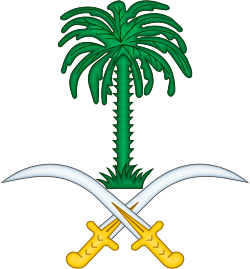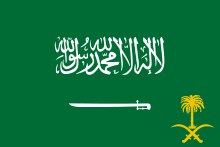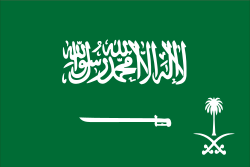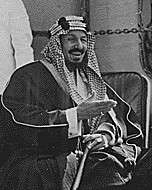Faisal of Saudi Arabia
Faisal bin Abdulaziz Al Saud (Arabic: فيصل بن عبدالعزيز آل سعود Fayṣal ibn ‘Abd al-‘Azīz Āl Su‘ūd; 14 April 1906 – 25 March 1975) was King of Saudi Arabia from 2 November 1964 to 25 March 1975.
| Faisal of Saudi Arabia | |||||
|---|---|---|---|---|---|
 | |||||
| King of Saudi Arabia | |||||
| Reign | 2 November 1964 – 25 March 1975 | ||||
| Bay'ah | 2 November 1964 | ||||
| Predecessor | Saud | ||||
| Successor | Khalid | ||||
| Prime Minister of Saudi Arabia | |||||
| In office 31 October 1962 – 25 March 1975 | |||||
| Monarch | Saud Himself | ||||
| Preceded by | Saud | ||||
| Succeeded by | Khalid | ||||
| In office 16 August 1954 – 21 December 1960 | |||||
| Monarch | Saud | ||||
| Preceded by | Saud | ||||
| Succeeded by | Saud | ||||
| Minister of Foreign Affairs | |||||
| In office 19 December 1930 – 22 December 1960 | |||||
| Monarch | Abdulaziz Saud | ||||
| Preceded by | Office created | ||||
| Succeeded by | Ibrahim bin Abdullah Al Suwaiyel | ||||
| In office 16 March 1962 – 25 March 1975 | |||||
| Monarch | Saud Himself | ||||
| Preceded by | Ibrahim bin Abdullah Al Suwaiyel | ||||
| Succeeded by | Saud bin Faisal Al Saud | ||||
| Born | 14 April 1906 Riyadh, Emirate of Nejd and Hasa | ||||
| Died | 25 March 1975 (aged 68) Riyadh, Saudi Arabia[1] | ||||
| Burial | 26 March 1975 Al-Oud cemetery, Riyadh | ||||
| Spouse | Sultana bint Ahmed Al Sudairi Iffat Al-Thunayan Al Jawhara bint Saud Al Kabir Haya bint Turki Al Turki | ||||
| Issue Detail | Numerous | ||||
| |||||
| House | House of Saud | ||||
| Father | King Abdulaziz | ||||
| Mother | Tarfa bint Abdullah bin Abdullatif Al Sheikh | ||||
Faisal was the third son of King Abdulaziz.[note 1] His mother, Tarfa, was a member of the Al ash-Sheikh family which has produced many prominent Saudi religious leaders. Faisal emerged as an influential royal politician under his father and brother King Saud, serving as foreign minister of the Saudi domains for all but two years from 1930 until his death. He was crown prince after Saud's accession in 1953, and in that position he outlawed slavery in Saudi Arabia. He persuaded King Saud to abdicate in his favour in 1964 with the help of other members of the royal family and his relative, Grand Mufti Muhammad ibn Ibrahim Al ash-Sheikh.
Faisal implemented a policy of modernization and reform. His main foreign policy themes were pan-Islamism, anti-communism (which he associated with Zionism),[2] and pro-Palestinianism.[3] He attempted to limit the power of Islamic religious officials. Protesting against support that Israel received from the West, he led the oil embargo which caused the 1973 oil crisis.
Faisal successfully stabilized the kingdom's bureaucracy, and his reign had significant popularity among Saudi Arabians[4] despite his reforms facing some controversy. In 1975, he was assassinated by his nephew Faisal bin Musaid.
Early life and education
Faisal bin Abdulaziz was born in Riyadh on 14 April 1906.[5][6][7] He was the third son of King Abdulaziz.[8] His mother was Tarfa bint Abdullah bin Abdullatif Al Sheikh,[9] whom Abdulaziz had married in 1902 after capturing Riyadh. She was from the Al ash-Sheikh family, descendants of Muhammad ibn Abd al-Wahhab.[10][11] Faisal's maternal grandfather, Abdullah bin Abdullatif, was one of Abdulaziz's principal religious teachers and advisers.[12][13] Faisal's mother died in 1912 when he was quite young.[12] Following this Faisal began to live with his maternal grandfather, Abdullah bin Abdullatif, who educated him.[12]
Faisal had only one full sister, Nourah. She married her cousin, Khalid bin Muhammad bin Abdul Rahman, son of Muhammad bin Abdul Rahman.[14] According to Helen Chapin Metz, Faisal, and most of his generation, was raised in an atmosphere in which courage was extremely valued and reinforced, and he was motivated by his mother to develop the values of tribal leadership.[15]
In 1919 the British government invited King Abdulaziz to visit London. He could not go, but sent Prince Faisal, making him the first ever Saudi Arabian royal to visit England. His visit lasted for five months, and he met with British officials.[16] During the same period, he also visited France, again being the first Saudi Arabian royal to pay an official visit there.[17]
Early political experience
As one of King Abdulaziz's eldest sons, Prince Faisal was given numerous responsibilities to consolidate control over Arabia. After the capture of Hail and initial control over Asir in 1922, he was sent to these provinces with nearly six thousand fighters. He achieved complete control over Asir at the end of the year.[18] Prince Faisal was appointed viceroy of Hejaz in 1926[19] following his father's takeover of the region.[20] He often consulted with local leaders during his tenure.[21]
In 1930 he became the minister of foreign affairs. He would continue to oversee Saudi foreign policy until his death—even as king, with only a two-year break[22] between 1960 and 1962.[20] Faisal visited Europe several times in this period, including Poland in 1932 and Russia (as part of the USSR) in 1933.[23][24] He commanded a campaign during the Saudi–Yemeni War in 1934, resulting in a Saudi victory.[20]
Crown prince and prime minister

Upon the accession of Prince Faisal's elder brother, King Saud, to the throne in 1953, Prince Faisal was appointed crown prince. King Saud embarked on a spending program that included the construction of a massive royal residence on the outskirts of the capital, Riyadh. He also faced pressure from neighboring Egypt, where Gamal Abdel Nasser had overthrown the monarchy in 1952. Nasser was able to cultivate a group of dissident princes led by Prince Talal, who defected to Egypt (see Free Princes). Fearing that King Saud's financial policies were bringing the state to the brink of collapse, and that his handling of foreign affairs was inept, senior members of the royal family and the ulema (religious leadership) pressured Saud into appointing Faisal to the position of prime minister in 1958, giving Faisal wide executive powers.[25]
A power struggle ensued between King Saud and Crown Prince Faisal, and on 18 December 1960, Prince Faisal resigned as prime minister in protest, arguing that King Saud was frustrating his financial reforms. King Saud took back his executive powers and, having induced Prince Talal to return from Egypt, appointed him as minister of finance in July 1958.[26][27] In 1962, however, Prince Faisal rallied enough support within the royal family to install himself as prime minister for a second time.[25] Less than a month before this event Prince Faisal and the Kennedy administration held a secret meeting on 4 October 1962.[28]
In 1963 Prince Faisal established the country's first television station, though actual broadcasts would not begin for another two years.[29] Crown Prince Faisal helped establish the Islamic University of Madinah in 1961. In 1962 Prince Faisal helped found the Muslim World League, a worldwide charity to which the Saudi royal family has reportedly since donated more than a billion dollars.[30]
Struggle with King Saud
The struggle with King Saud continued in the background during this time. Taking advantage of the king's absence from the country for medical reasons in early 1963, Faisal began amassing more power for himself. He removed many of Saud's loyalists from their posts and appointed like-minded princes in key military and security positions,[31][32] such as his brother Prince Abdullah, to whom he gave command of the National Guard in 1962. Upon King Saud's return, Prince Faisal demanded that he be made regent and that King Saud be reduced to a purely ceremonial role. In this, he had the crucial backing of the ulema (elite Islamic scholars), including a fatwā (edict) issued by the grand mufti of Saudi Arabia, a relative of Prince Faisal on his mother's side, calling on King Saud to accede to his brother's demands.[33]
King Saud refused, however, and made a last-ditch attempt to retake executive powers, leading Prince Faisal to order the National Guard to surround King Saud's palace. His loyalists outnumbered and outgunned, King Saud relented, and on 4 March 1964, Prince Faisal was appointed regent. A meeting of the elders of the royal family and the ulema was convened later that year, and a second fatwā was decreed by the grand mufti, calling on King Saud to abdicate the throne in favor of his brother. The royal family supported the fatwā and immediately informed King Saud of their decision. King Saud, by now shorn of all his powers, agreed, and Prince Faisal was proclaimed king on 2 November 1964.[25][32] Saud then went into exile, finding refuge in Egypt before eventually settling in Greece.[34]
King of Saudi Arabia
In a speech shortly after he came to power on 2 November 1964, Faisal said:
I beg of you, brothers, to look upon me as both brother and servant. 'Majesty' is reserved to God alone and 'the throne' is the throne of the Heavens and Earth.[35]
In 1967 King Faisal established the post of second prime minister and appointed his half-brother Prince Fahd to this post.[36]
Modernization
Early in his rule, he issued an edict that all Saudi princes had to school their children inside the country, rather than sending them abroad; this had the effect of making it popular for upper-class families to bring their sons back to study in the Kingdom.[37] King Faisal also introduced the country's current system of administrative regions, and laid the foundations for a modern welfare system. In 1970 he established the Ministry of Justice and inaugurated the country's first "five-year plan" for economic development.[38]
One of his modernization attempts was the new laws on media, publishing, and archiving and bilateral cultural cooperation protocols with foreign and corporate archives that kept records about mid-twentieth century Arabia.[28] Television broadcasts officially began in 1965. In 1966 a nephew of Faisal attacked the newly established headquarters of Saudi television but was killed by security personnel. The attacker was the brother of Faisal's future assassin, and the incident is the most widely accepted motive for the murder.[39]
Steps against coups d'état

The 1950s and 1960s saw numerous coups d'état in the region. Muammar al-Gaddafi's coup that overthrew the monarchy in oil-rich Libya in 1969 was especially threatening for Saudi Arabia due to the similarity between the two sparsely-populated desert countries.[40] As a result, King Faisal undertook to build a sophisticated security apparatus and cracked down firmly on dissent. As in all affairs, King Faisal justified these policies in Islamic terms. Early in his reign, when faced with demands for a written constitution for the country, King Faisal responded that "our constitution is the Quran".[41] In the summer of 1969 King Faisal ordered the arrest of hundreds of military officers, including some generals,[42] alleging that a military coup d'état was being planned. The coup was planned primarily by air force officers and aimed at overthrowing the monarchy and founding a Nasserist regime in the country.[43] The arrests were possibly based on a tip from American intelligence.[40]
Religious inclusiveness
King Faisal seemed to hold the pluralist view, favouring limited, cautious accommodation of popular demands for inclusive reform, and made repeated attempts to broaden political representation, harking back to his temporarily successful national integration policy from 1965 to 1975. King Faisal acknowledged his country's religious and cultural diversity, which includes the predominantly Shia al-Ahsa in the east; the Asir in the southwest, with tribal affinities to Yemen, especially among the Ismaili tribes of Najran and Jizan; and the Kingdom of the Hejaz, with its capital Mecca. He included non-Wahhabi, cosmopolitan Sunni Hejazis from Mecca and Jeddah in the Saudi government. However, after his reign, discrimination based on sect, tribe, region, and gender became the order of the day and has remained as such until today.[44]
The role and authority of the ulema declined after the rise of King Faisal even though they had helped bring him to the throne in 1964. Despite his piety and biological relationship through his mother to the Al as Shaykh family, and his support for the pan-Islamic movement in his struggle against pan-Arabism, he decreased the ulema's power and influence.[45] Unlike his successor King Khalid, King Faisal attempted to prevent radical clerics from controlling religious institutions such as the Council of Senior Ulema, the highest religious institution in Saudi Arabia, or taking religious offices such as Grand Mufti, responsible for preserving Islamic law. But his advisers warned that, once religious zealots had been motivated, disastrous effects would result.[30] King Faisal rejected the ulema's opposition to aspects of his accelerated modernization attempts, sometimes even in matters considered by them to be major issues[45] such as education for women.[46]
Corruption in the royal family was taken very seriously by religious figures in the Islamic theological colleges. They challenged some of the accepted theological interpretations adopted by the Saudi regime. One such influential figure was Shaykh bin Baz, then rector of the Al Medina college of theology. King Faisal would not tolerate his criticism and had him removed from his position. However, his teachings had already radicalized some of his students. One of them was Juhayman al-Otaybi.[47]
Abolition of slavery
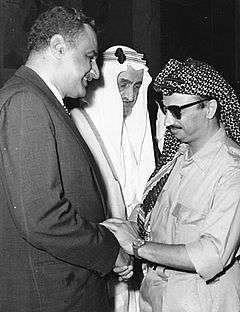
Slavery did not vanish in Saudi Arabia until King Faisal issued a decree for its total abolition in 1962. BBC presenter Peter Hobday stated that about 1,682 slaves were freed at that time, at a cost to the government of $2,000 each.[47] The political analyst Bruce Riedel argued that the US began to raise the issue of slavery after the meeting between King Abdulaziz and US president Franklin D. Roosevelt in 1945 and that John F. Kennedy finally persuaded the House of Saud to abolish slavery in 1962.[48]
Foreign relations
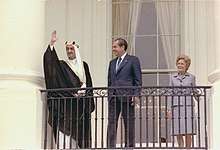
As king, Faisal continued the close alliance with the United States begun by his father, and relied on the US heavily for arming and training his armed forces. King Faisal was anti-communist. He refused any political ties with the Soviet Union and other Communist bloc countries, professing to see a complete incompatibility between communism and Islam.[49]
Between 23 and 25 September 1969, King Faisal convened a conference in Rabat, Morocco, to discuss the arson attack on the Al Aqsa Mosque that had occurred a month earlier. The leaders of 25 Muslim states attended and the conference called for Israel to give up territory conquered in 1967. The conference also set up the Organisation of Islamic Cooperation and pledged its support for the Palestinians.[50]
Following the death of Nasser in 1970, King Faisal drew closer to Egypt's new president, Anwar Sadat, who himself was planning a break with the Soviet Union and a move towards the pro-American camp. During the 1973 Arab–Israeli War, launched by Sadat, King Faisal withdrew Saudi oil from world markets, in protest over Western support for Israel during the conflict. This action increased the price of oil and was the primary force behind the 1973 oil crisis. It was to be the defining act of King Faisal's career, and gained him lasting prestige among many Arabs and Muslims worldwide. In 1974 he was named Time magazine's Man of the Year, and the financial windfall generated by the crisis fueled the economic boom that occurred in Saudi Arabia after his death. The new oil revenue also allowed Faisal to greatly increase the aid and subsidies begun following the 1967 Six-Day War[3] to Egypt, Syria, and the Palestine Liberation Organization.[51] It is a commonly-held belief in Saudi Arabia, and the wider Arab world, that King Faisal's oil embargo was the real cause of his assassination, via a Western conspiracy.[52][53]
Personal life
King Faisal was married four times concurrently.[54] He divorced twice and widowed once.[54] His spouses were from powerful families: Al Kabir, Al Sudairi, Al Jiluwi and Al Thunayan.[55] His wives were:
- Sultana bint Ahmed Al Sudairi, the mother of his eldest son Prince Abdullah, whom Faisal fathered when he was only fifteen. Sultana was from the Sudairi family and the younger sister of Hassa bint Ahmed, the mother of the Sudairi brothers.[56]
- Iffat Al-Thunayan (1916–2000), who was born and raised in Turkey. Her ancestors of the Al Thunayan branch of the Al Saud family[57] were taken to Istanbul or Cairo by Egyptian forces in 1818. They first met in Istanbul around 1932 while he was in Turkey for an official visit.[16] Prince Faisal took Iffat to Jeddah where they were married in 1932.[16][58] They had nine children,[57] including Prince Mohammed, Prince Saud, and Prince Turki.[59] Iffat was credited with being the influence behind many of her husband's reforms, particularly with regard to women.[60][61]
- Al Jawhara bint Saud bin Abdulaziz Al Saud Al Kabir, the daughter of his aunt Nuora bint Abdul Rahman. They married in October 1935. With Al Jawhara, Faisal had a daughter, Mashael.[62]
- Haya bint Turki bin Abdulaziz Al Turki, the mother of Princess Mishail, Prince Saad and Prince Khalid.[56] She was a member of the Al Jiluwi clan.[9][63]
Faisal's sons were all educated abroad.[54] Prince Turki received formal education at prestigious schools in New Jersey, and he later attended Georgetown University,[64] while Prince Saud was an alumnus of Princeton University. King Faisal's sons have held, and continue to hold, important positions in the Saudi government. His eldest son, Prince Abdullah (born in 1922), held governmental positions for a while. Prince Khalid was the governor of Asir Province in southwestern Saudi Arabia for more than three decades before becoming governor of Makkah Province in 2007. Prince Saud was the Saudi foreign minister between 1975 and 2015. Prince Turki served as head of Saudi Intelligence, ambassador to the United Kingdom, and later ambassador to the United States.[65] Prince Abdul Rahman who was a graduate of Sandhurst Military Academy died in March 2014. Prince Mohammed was a businessman who died in 2017. Prince Saad died in April 2017.[66]
King Faisal's daughter Haifa is married to Bandar bin Sultan. By giving Haifa's hand in marriage to Prince Bandar, King Faisal forced Bandar's father Prince Sultan to recognize Bandar as a legitimate prince. Another daughter, Lolowah, is a prominent activist for women's education in Saudi Arabia. In 1962 his daughter Princess Sara founded one of the first charitable organizations, Al Nahda, which won the first Chaillot prize for human rights organisations in the Gulf in 2009.[67] Her spouse was Muhammed bin Saud, who was one of King Saud's sons. One of his daughters, Prince Khalid's full sister Princess Mishail, died at the age of 72 in October 2011.[68] His granddaughter, Princess Reem Al Faisal who is the daughter of Prince Mohammed, is a photographer and gallery owner based in Jeddah.[69][70]
King Faisal spoke fluent English and French,[71] as does his daughter Princess Lolowah.[72]
Assassination
On 25 March 1975 King Faisal was shot point-blank and killed by his half-brother's son, Faisal bin Musaid, who had just come back from the United States. The murder occurred at a majlis (literally 'a place for sitting'), an event where the king or leader opens up his residence to the citizens to enter and petition the king.[73]
In the waiting room, Prince Faisal talked to Kuwaiti representatives who were also waiting to meet King Faisal. When the Prince went to embrace him, King Faisal leaned to kiss his nephew in accordance with Saudi custom. At that instant, Prince Faisal took out a pistol and shot him. The first shot hit King Faisal's chin and the second one went through his ear. A bodyguard hit Prince Faisal with a sheathed sword. Oil minister Zaki Yamani yelled repeatedly not to kill the prince.[74]
King Faisal was quickly taken to a hospital. He was still alive as doctors massaged his heart and gave him a blood transfusion. Their efforts were unsuccessful, and King Faisal died shortly afterward. Both before and after the attack the prince was reported to be calm. Following the killing, Riyadh had three days of mourning during which all government activities were suspended.[74]
One theory for the murder was avenging the death of Prince Khalid bin Musaid, the brother of Prince Faisal bin Musaid. King Faisal instituted modern and secular reforms that led to the installation of television, which provoked violent protests, one of which was led by Prince Khalid, who, during the course of an attack on a television station in 1966, was shot dead by a policeman.[75]
Prince Faisal, who was captured directly after the attack, was at first officially declared insane, but following the trial a panel of Saudi medical experts decided that he was sane when he shot the king. The nation's high religious court convicted him of regicide and sentenced him to execution. He was beheaded in the public square in Riyadh.[74]
King Faisal's body was buried in Al Oud cemetery in Riyadh on 26 March 1975.[76][77] His successor, King Khalid, wept over his body at his funeral.[78]
Memorials and legacy
After his death, the King Faisal Foundation, a philanthropic organisation, was established in King Faisal's honour.[79] King Faisal was eulogized by lyricist Robert Hunter in the title track of the Grateful Dead's 1975 album Blues for Allah.[80] In 2013 Russian Arabist Alexei Vassiliev published a biography, King Faisal of Saudi Arabia: Personality, Faith and Times.[2] A movie directed by Agustí Villaronga in 2019 entitled Born a King is about the visit of King Faisal to London in 1919 when he was fourteen years old.[81]
Lyallpur, the third largest city of Pakistan, was renamed Faisalabad (literally, "City of Faisal") in 1979 in his honor.[82] One of the two major Pakistan Air Force bases in Pakistan's Sindh province's largest city, Karachi, is named "PAF Base Faisal" in honour of King Faisal.[83]
Ancestry
| Ancestors of Faisal of Saudi Arabia | ||||||||||||||||||||||||||||||||||||||||||||||||||||||||||||||||||||||||||||||||||||||||||||||||||||||||||||||||||||||||||||||||||||||||||||||||||||||||||||||||||||||||||||||||||||||||||||||||||||||||||||||||||||||||||||||||||||||
|---|---|---|---|---|---|---|---|---|---|---|---|---|---|---|---|---|---|---|---|---|---|---|---|---|---|---|---|---|---|---|---|---|---|---|---|---|---|---|---|---|---|---|---|---|---|---|---|---|---|---|---|---|---|---|---|---|---|---|---|---|---|---|---|---|---|---|---|---|---|---|---|---|---|---|---|---|---|---|---|---|---|---|---|---|---|---|---|---|---|---|---|---|---|---|---|---|---|---|---|---|---|---|---|---|---|---|---|---|---|---|---|---|---|---|---|---|---|---|---|---|---|---|---|---|---|---|---|---|---|---|---|---|---|---|---|---|---|---|---|---|---|---|---|---|---|---|---|---|---|---|---|---|---|---|---|---|---|---|---|---|---|---|---|---|---|---|---|---|---|---|---|---|---|---|---|---|---|---|---|---|---|---|---|---|---|---|---|---|---|---|---|---|---|---|---|---|---|---|---|---|---|---|---|---|---|---|---|---|---|---|---|---|---|---|---|---|---|---|---|---|---|---|---|---|---|---|---|---|---|---|
| ||||||||||||||||||||||||||||||||||||||||||||||||||||||||||||||||||||||||||||||||||||||||||||||||||||||||||||||||||||||||||||||||||||||||||||||||||||||||||||||||||||||||||||||||||||||||||||||||||||||||||||||||||||||||||||||||||||||
Notes
- The eldest son, Prince Turki of Nejd, and the second son, the eventual King Saud of Saudi Arabia, were both children of Wadhah bint Muhammad bin 'Aqab.
References
- "King Faisal assassinated". History.com. 9 February 2010. Retrieved 25 December 2018.
- "Unexpectedly modern". The Economist. 26 January 2013. Retrieved 17 July 2013.
- "King Faisal: Oil, Wealth and Power", TIME Magazine, 7 April 1975.
- Hertog, Steffen. Princes, Brokers, and Bureaucrats: Oil and the State in Saudi Arabia. Ithaca: Cornell UP, 2010. Print.
- "King Faisal Ibn Abdul Aziz Al Saud, Saudi Arabia". Retrieved 25 June 2012.
- George Kheirallah (1952). Arabia Reborn. Albuquerque: University of New Mexico Press. p. 254. – via Questia (subscription required)
- "The kings of the Kingdom". Ministry of Commerce and Industry. Archived from the original on 22 October 2012. Retrieved 28 July 2012.
- Nabil Mouline (April–June 2012). "Power and generational transition in Saudi Arabia" (PDF). Critique Internationale. 46: 1–22. Retrieved 24 April 2012.
- Winberg Chai (22 September 2005). Saudi Arabia: A Modern Reader. University Press of America. p. 193. ISBN 978-0-88093-859-4.
- "Wahhabism – A Unifier or a Divisive Element". APS Diplomat News Service. 7 January 2013. Retrieved 26 March 2013.
- "The New Succession Law Preserves The Monarchy While Reducing The King's Prerogatives". Wikileaks. 22 November 2006. Archived from the original on 19 November 2013. Retrieved 21 July 2013.
- Alexander Bligh (1985). "The Saudi religious elite (Ulama) as participant in the political system of the kingdom". International Journal of Middle East Studies. 17: 37–50. doi:10.1017/S0020743800028750.
- "Riyadh. The capital of monotheism" (PDF). Business and Finance Group. Archived from the original (PDF) on 14 October 2009. Retrieved 22 July 2013.
- As'ad AbuKhalil (2004). The Battle for Saudi Arabia. Royalty, fundamentalism and global power. New York City: Seven Stories Press. ISBN 1-58322-610-9.
- Helen Chapin Metz, ed. (1992). Saudi Arabia: A Country Study. Washington: GPO for the Library of Congress. Retrieved 2 May 2012.
- Leon Hesser (30 November 2004). Nurture the Heart, Feed the World: The Inspiring Life Journeys of Two Vagabonds. BookPros, LLC. p. 104. ISBN 978-0-9744668-8-0.
- Mark Weston (28 July 2008). Prophets and Princes: Saudi Arabia from Muhammad to the Present. John Wiley & Sons. p. 129. ISBN 978-0-470-18257-4.
- Mohammad Zaid Al Kahtani (December 2004). "The Foreign Policy of King Abdulaziz" (PDF). University of Leeds. Retrieved 21 July 2013.
- Helmut Mejcher (May 2004). "King Faisal bin Abdulaziz Al Saud in the Arena of World Politics: A Glimpse from Washington, 1950 to 1971" (PDF). British Journal of Middle Eastern Studies. 31 (1): 5–23. doi:10.1080/1353019042000203412. Archived from the original (PDF) on 9 May 2013.
- "Fayṣal (King of Saudi Arabia)". Encyclopedia Britannica. 20 July 1998. Retrieved 25 December 2018.
- Ghassane Salameh; Vivian Steir (October 1980). "Political Power and the Saudi State". MERIP (91): 5–22. doi:10.2307/3010946. JSTOR 3010946.
- "Mofa.gov.sa". mofa.gov.sa. Retrieved 24 January 2015.
- T. R. McHale (Autumn 1980). "A Prospect of Saudi Arabia". International Affairs. 56 (4): 622–647. doi:10.2307/2618170. JSTOR 2618170.
- "Seminar focuses on King Faisal's efforts to promote world peace". Arab News. 30 May 2002. Retrieved 11 August 2013.
- "King Faisal". LookLex Encyclopaedia. Retrieved 16 September 2019.
- "About Ministry of Finance". www.mof.gov.sa.
- Vassiliev, Alexei. (1998). The History of Saudi Arabia, London, UK: Al Saqi Books, p. 358
- Rosie Bsheer (August 2017). "W(h)ither Arabian Peninsula Studies?". In Amal Ghazal; Jens Hanssen (eds.). The Oxford Handbook of Contemporary Middle-Eastern and North African History. Oxford.
- "A history of treason – King Faisal bin Abdulaziz bin Abdul Rahman Al Saud". Islam Times. 22 May 2014. Retrieved 5 November 2014.
- Rachel Bronson (2005). "Rethinking Religion: The Legacy of the US–Saudi Relationship" (PDF). The Washington Quarterly. 28 (4): 121–137. doi:10.1162/0163660054798672.
- Wynbrandt, James, A Brief History of Saudi Arabia, New York: Facts on File, Inc., 2004, p. 221
- Vassiliev, p. 366–7
- Wynbrandt, James, A Brief History of Saudi Arabia, New York: Facts on File, Inc., 2004, p. 225
- Joseph A. Kechichian (2001). Succession in Saudi Arabia. New York: Palgrave.
- Sherifa Zuhur (31 October 2011). Saudi Arabia. ABC-CLIO. p. 52. ISBN 978-1-59884-571-6.
- Nadav Safran (1985). Saudi Arabia: The Ceaseless Quest for Security. Cornell University Press. p. 217. ISBN 978-0-8014-9484-0.
- Bergen, Peter, "The Osama bin Laden I Know', 2006.
- j. Kostiner, C. E. Bosworth, E. van Donzel and W. P. Heinrichs. (2007)."al- Suʿūdiyya, al- Mamlaka al- ʿArabiyya." Encyclopaedia of Islam. Edited by P. Bearman, Th. Bianquis, Brill. Brill Online. 28 March 2007
- Vassiliev 395.
- Vassiliev 371.
- Official website of the Saudi Deputy Minister of Defense, official Saudi government journal Umm Al-Qura Issue 2193, 20 October 1967 Archived 6 November 2014 at the Wayback Machine
- Tietelbaum, Joshua. ""A Family Affair: Civil-Military Relations in the Kingdom of Saudi Arabia"" (PDF). Archived from the original on 25 June 2008. Retrieved 25 June 2008.CS1 maint: BOT: original-url status unknown (link), p. 11.
- Roham Alvandi (2012). "Nixon, Kissinger, and the Shah: the origins of Iranian primacy in the Persian Gulf" (PDF). Diplomatic history. 36 (2): 337–372. doi:10.1111/j.1467-7709.2011.01025.x. Archived from the original (PDF) on 20 July 2013. Retrieved 2 August 2013.
- Mai Yamani (February–March 2008). "The two faces of Saudi Arabia". Survival. 50 (1): 143–156. doi:10.1080/00396330801899488.
- Mordechai Abir (1987). "The Consolidation of the Ruling Class and the New Elites in Saudi Arabia". Middle Eastern Studies. 23 (2): 150–171. doi:10.1080/00263208708700697. JSTOR 4283169.
- "Educated for indolence". The Guardian. 2 August 1999. Retrieved 12 June 2018.
- Nehme, Michel G. (1994). "Saudi Arabia 1950–80: Between Nationalism and Religion". Middle Eastern Studies. 30 (4). JSTOR 4283682.
- Bruce Riedel (2011). "Brezhnev in the Hejaz" (PDF). The National Interest. 115. Archived from the original (PDF) on 15 November 2013. Retrieved 23 April 2012.
- King Faisal Ibn Abdul Aziz Al Saud. The Saudi Network.
- Vassiliev, Alexei (2012) King Faisal of Saudi Arabia: Personality, Faith and Times. Saqi. ISBN 978-0-86356-689-9. pp. 333-334
- "TIME Magazine – U.S. Edition – 10 March 2014 Vol. 183 No. 9". Time. 10 March 2014. Retrieved 24 January 2015.
- Muhammad Hassanein Heykal, "The Saudi Era" (in Arab Reports and Analysis), Journal of Palestine Studies, Vol. 6 (4).(Summer, 1977), p. 160. Retrieved via JSTOR
- Fred Halliday (11 August 2005). "Political killing in the cold war". Open Democracy. Retrieved 17 July 2013.
- "The Life and Times of the Cautious King of Araby". Time Magazine. 102 (21). 19 November 1973. Retrieved 8 August 2020.
- William B. Quandt (1981). Saudi Arabia in the 1980s: Foreign Policy, Security, and Oil. Washington DC: The Brookings Institution. p. 79.
- Joseph A. Kechichian (2001). Succession in Saudi Arabia. New York: Palgrave.
- Jennifer S. Uglow; Frances Hinton; Maggy Hendry (1999). The Northeastern Dictionary of Women's Biography. UPNE. p. 273. ISBN 978-1-55553-421-9.
- Ghada Talhami (1 December 2012). Historical Dictionary of Women in the Middle East and North Africa. Rowman & Littlefield. p. 170. ISBN 978-0-8108-6858-8.
- "Saudi Arabia mourns passing away of princess". Kuwait News Agency. 12 February 2000. Retrieved 6 June 2012.
- "King Faisal Assassinated." Lewiston Evening Journal, Lewiston-Auburn, Maine 25 March 1975: 1+. Print.
- Mark Weston (28 July 2008). Prophets and Princes: Saudi Arabia from Muhammad to the Present. John Wiley & Sons. p. 169. ISBN 978-0-470-18257-4.
- "General Index". King Khalid Foundation. Archived from the original on 27 May 2013. Retrieved 4 August 2012.
- Mordechai Abir (1988). Saudi Arabia in the Oil Era: Regime and Elites: Conflict and Collaboration. Kent: Croom Helm.
- "Reflections on US-Saudi Relations". Georgetown University. 2008. Retrieved 25 May 2009.
- "Embassy official: Saudi ambassador to U.S. resigns". CNN. 2006. Archived from the original on 11 January 2007. Retrieved 17 December 2006.
- "Saudi Royal Court: Prince Saad bin Faisal bin Abdulaziz dies". Sharjah 24. 11 April 2017. Retrieved 12 July 2020.
- Ana Echagüe; Edward Burke (June 2009). "'Strong Foundations'? The Imperative for Reform in Saudi Arabia" (PDF). FRIDE (Spanish Think-tank organization). pp. 1–23. Archived from the original (PDF) on 29 October 2013. Retrieved 15 April 2012.
- "Princess Mashael bint Faisal passes away". Life in Riyadh. 3 October 2011. Archived from the original on 8 July 2013. Retrieved 4 May 2012.
- Bekhrad, Joobin (1 March 2016). "Shiny Happy People". Reorient. Retrieved 13 March 2016.
- "Chris Hardwick sold his house to Princess Reem Al Faisal". Dirt. 12 October 2016. Retrieved 9 August 2020.
- "Man in the news. King Faisal". The Telegraph. 5 November 1964. Retrieved 21 July 2013.
- Cassandra Jardine (12 December 2005). "'There's such ignorance about us'". The Daily Telegraph. Retrieved 2 May 2011.
- James Wynbrandt (2010). A Brief History of Saudi Arabia. Infobase Publishing. p. 236. ISBN 978-0-8160-7876-9.
- "1975: Saudi's King Faisal assassinated". BBC. 25 March 1975. Retrieved 17 July 2013.
- David Commins (2006). The Wahhabi Mission and Saudi Arabia. p. 110. ISBN 1-84511-080-3.
- Abdul Nabi Shaheen (23 October 2011). "Sultan will have simple burial at Al Oud cemetery". Gulf News. Retrieved 29 July 2012.
- Ross, Michael (26 March 1975). "Brother of murdered King assumes throne". Times Union. Retrieved 2 August 2012.
- Ludington, Nick. (24 March 1975) Public Execution Expected. Daily News [Bowling Green, Kentucky], p. 5.
- "King Faisal Center for Research and Islamic Studies (KFCRIS)". Datarabia. Retrieved 12 June 2018.
- "The Sounds of the '60s: How Dick Dale, the Doors, and Dylan Swayed to Arab Music". Alternet. 3 December 2008. Archived from the original on 12 June 2018. Retrieved 26 May 2012.
- "Born a King (2019)". IMDb. Retrieved 12 July 2020.
- Shahid Javed Burki (2018). Historical Dictionary of Pakistan. Rowman & Littlefield. p. 196. ISBN 978-1-4422-4148-0.
- "Pakistan Air Force". paf.gov.pk. Archived from the original on 26 June 2010. Retrieved 24 January 2015.
- Fahd Al Semmari (Summer 2001). "The King Abdulaziz Foundation for Research and Archives". Middle East Studies Association Bulletin. 35 (1): 45–46. doi:10.1017/S0026318400041432. JSTOR 23063369.
External links


- Newspaper clippings about Faisal of Saudi Arabia in the 20th Century Press Archives of the ZBW
Faisal of Saudi Arabia Born: 1906 Died: 1975 | ||
| Regnal titles | ||
|---|---|---|
| Preceded by Saud |
King of Saudi Arabia 2 November 1964 – 25 March 1975 |
Succeeded by Khalid |
| Saudi Arabian royalty | ||
| Preceded by Saud |
Crown Prince of Saudi Arabia 9 November 1953 – 2 November 1964 |
Succeeded by Muhammad |
| Political offices | ||
| New title | Minister for Foreign Affairs of Saudi Arabia 1930–1960 |
Succeeded by Ibrahim bin Abdullah Al Suwaiyel |
| Preceded by Ibrahim bin Abdullah Al Suwaiyel |
Minister for Foreign Affairs of Saudi Arabia 1962–1975 |
Succeeded by Saud bin Faisal bin Abdulaziz Al Saud |
| Preceded by Saud bin Abdulaziz Al Saud |
Prime Minister of Saudi Arabia 1954–1960 |
Succeeded by Saud bin Abdulaziz Al Saud |
| Prime Minister of Saudi Arabia 1962–1975 |
Succeeded by Khalid bin Abdulaziz Al Saud | |
